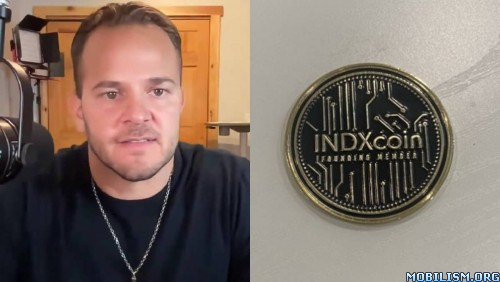Church Pastor Pockets Millions through Crypto Scheme Fraud, Claims God “Told Him to Do It
012624*
A Colorado pastor accused of conning his own congregation out of millions of dollars by promoting a useless crypto coin claims that God Himself told him to do it.
Eli Regalado and his wife Kaitlyn are being investigated for fraud after allegedly launching and peddling a useless cryptocurrency as a a low-risk, high-profit investment pegged to the average value of the top 100 cryptocurrencies. In reality, INDXcoin was “illiquid and practically worthless,” according to the Colorado Division of Securities, and only available through the Regalados’ proprietary crypto exchange, called Kingdom Wealth Exchange, which the pastor shut down last year, making the coin virtually useless. Now Regalado claims that the whole thing was God’s idea, although he admits that he may have “misunderstood” his message.

“It was last October [20]21 that the Lord brought this cryptocurrency to me,” Eli Regalado said in a video update to INDXcoin “investors”. “The Lord said, ‘Take this to my people for a wealth transfer, I want you to build this.” We took God at his word and sold a cryptocurrency with no clear exit.”
Apparently, God actually insisted that Regalado build and promote INDXcoin to his followers despite his reluctance to do so. He told the Division of Securities that he had no previous experience with cryptocurrencies, but that didn’t make a difference to the Lord.
“I said: Lord, I don’t want to do this. I don’t know how to do this. I don’t have any experience in this industry. I don’t know what I’m doing. I don’t want to be caught up in something,” Regalado recalled. “God is in the business of doing new things and breaking seals. And he did tell us to do this.”

Eli and Kaitlyn Regalado are accused of advertising INDXcoin through presentations at his church and at others he found through other pastors and raking in $3.2 million from gullible investors who believed it was God’s creation. Although he claimed that it was an exchange malfunction that spelled the end of INDXcoin last year, investigators found that the Regalados had used at least $1.3 million for personal benefit.
“Out of the $1.3 [million], half a million dollars went to the IRS, and a few hundred thousand dollars went to a home remodel the Lord told us to do,” Eli Regalado recently explained in a video, but investigators claim that they have evidence of other personal expenses from investor funds, like a Range Rover, luxury handbags, jewelry, boat rentals, and snowmobile adventures.
“We allege that Mr. Regalado took advantage of the trust and faith of his own Christian community and that he peddled outlandish promises of wealth to them when he sold them essentially worthless cryptocurrencies,” Colorado Securities Commissioner Tung Chan said.
Regalado, who reportedly found God 20 years ago, while serving a prison sentence for boosting cars. He began preaching for the online-only Victorious Grace Church, where he and his wife are listed as the only employees, and the rest, as they say, is history.
Speaking about the violations of Colorado’s anti-fraud, licensing, and registration laws that he and his wife stand accused of, Eli Regalado told his followers that he may have misinterpreted God’s message, but that a miracle is still possible.
Either I misheard God, and every one of you who prayed and came in — you as well. Or two, God is still not done with this project,” Regalado said. “What we’re believing for still is that God is going to do a miracle. God is going to work a miracle in the financial sector.”
A pastor scamming his parishioners isn’t that crazy if you really think about it, but you know what is? The reaction of Regalado’s followers to the situation. In the comments to a video of him bemoaning his situation and invoking God’s will, dozens of people continue to reassure him that God will “turn the situation around.”

dude looks exactly how i would imagine this bozo would look like
012624*
A Colorado pastor accused of conning his own congregation out of millions of dollars by promoting a useless crypto coin claims that God Himself told him to do it.
Eli Regalado and his wife Kaitlyn are being investigated for fraud after allegedly launching and peddling a useless cryptocurrency as a a low-risk, high-profit investment pegged to the average value of the top 100 cryptocurrencies. In reality, INDXcoin was “illiquid and practically worthless,” according to the Colorado Division of Securities, and only available through the Regalados’ proprietary crypto exchange, called Kingdom Wealth Exchange, which the pastor shut down last year, making the coin virtually useless. Now Regalado claims that the whole thing was God’s idea, although he admits that he may have “misunderstood” his message.

“It was last October [20]21 that the Lord brought this cryptocurrency to me,” Eli Regalado said in a video update to INDXcoin “investors”. “The Lord said, ‘Take this to my people for a wealth transfer, I want you to build this.” We took God at his word and sold a cryptocurrency with no clear exit.”
Apparently, God actually insisted that Regalado build and promote INDXcoin to his followers despite his reluctance to do so. He told the Division of Securities that he had no previous experience with cryptocurrencies, but that didn’t make a difference to the Lord.
“I said: Lord, I don’t want to do this. I don’t know how to do this. I don’t have any experience in this industry. I don’t know what I’m doing. I don’t want to be caught up in something,” Regalado recalled. “God is in the business of doing new things and breaking seals. And he did tell us to do this.”

Eli and Kaitlyn Regalado are accused of advertising INDXcoin through presentations at his church and at others he found through other pastors and raking in $3.2 million from gullible investors who believed it was God’s creation. Although he claimed that it was an exchange malfunction that spelled the end of INDXcoin last year, investigators found that the Regalados had used at least $1.3 million for personal benefit.
“Out of the $1.3 [million], half a million dollars went to the IRS, and a few hundred thousand dollars went to a home remodel the Lord told us to do,” Eli Regalado recently explained in a video, but investigators claim that they have evidence of other personal expenses from investor funds, like a Range Rover, luxury handbags, jewelry, boat rentals, and snowmobile adventures.
“We allege that Mr. Regalado took advantage of the trust and faith of his own Christian community and that he peddled outlandish promises of wealth to them when he sold them essentially worthless cryptocurrencies,” Colorado Securities Commissioner Tung Chan said.
Regalado, who reportedly found God 20 years ago, while serving a prison sentence for boosting cars. He began preaching for the online-only Victorious Grace Church, where he and his wife are listed as the only employees, and the rest, as they say, is history.
Speaking about the violations of Colorado’s anti-fraud, licensing, and registration laws that he and his wife stand accused of, Eli Regalado told his followers that he may have misinterpreted God’s message, but that a miracle is still possible.
Either I misheard God, and every one of you who prayed and came in — you as well. Or two, God is still not done with this project,” Regalado said. “What we’re believing for still is that God is going to do a miracle. God is going to work a miracle in the financial sector.”
A pastor scamming his parishioners isn’t that crazy if you really think about it, but you know what is? The reaction of Regalado’s followers to the situation. In the comments to a video of him bemoaning his situation and invoking God’s will, dozens of people continue to reassure him that God will “turn the situation around.”
dude looks exactly how i would imagine this bozo would look like






































